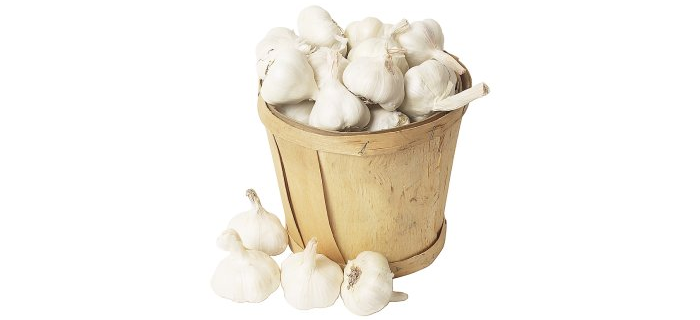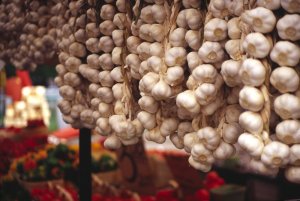Gotta Love Garlic!

Garlic is wonderful, and part of the wonderfulness is, it's pretty easy to grow. The main difference from many other crops is, this is one to plant now, in the fall, and to winter over.
Fall planted garlic builds a strong root system, and when spring rolls around and the ground warms again, it kicks into a growth spurt, well ahead of spring planted cloves. (Still, if time got away from you, or your cloves arrived late, spring planted cloves will grow. You'll get a more modest crop, but even a modest crop of garlic is something good to have.)
A garlic bulb is made up of multiple cloves around a central pithy stalk. Separate the cloves, plant each one individually - three to four inches apart for regular garlic, or 6 inches apart for elephant garlic, and each clove will multiply into a new multi cloved bulb. Later on, in summer, you'll know it's time to harvest when the stalks yellow. With stiffnecked type garlics, you can wait until the stalks dry out. With softnecked type garlics, such as silver skin, if you want to braid it, it's good to harvest while the stalks are still flexible. (See below about braiding.)
Prep work
Before you plant, though, do prepare your soil. Clear all weeds, especially any forms of grass that propagate by runners. Root out the competition and leave your garlic a clear field.
Garlic benefits from soil enrichment, also. Work in a layer of compost or well rotted manure first, before you plant your cloves.
Once planted, cover the bed with a layer of mulch from organic materials, such as leaves or grass clippings. (Never use black plastic!) An organic mulch adds nutrients to the soil, gives a layer of protection for winter, and helps keep weeds down.
Aside on mulch: I know people who've had problems with purchasing a bale of straw for mulch at a large chain garden center, only to discover it was full of seed heads that gave them weeds. So if you have to buy bales, look them over closely first. If you spot seed heads, go somewhere else. Still, a better option is to build your own compost pile and recycle your own leaves and clippings. This also assures you that no pesticides or toxins are used to produce it, which is especially desirable for mulching food gardens.

Braiding garlic
Craft note - have you seen big garlic braids that were cool looking but seemed very intimidating to try making, for a first attempt? Try a simpler one! If you can braid hair, you can braid this simple garlic kitchen decoration.
Select just three softnecked garlics with stalks attached. (Remember, this needs to be done while the stalks are still flexible, before they fully dry.) Tie the upper ends of the 3 garlics together with slender width ribbon or colorful yarn. Braid the stems down and tie off just above the cloves. Then decorate the braid with a bunch of dried flowers (strawflowers or statice work well) or tie on three ears of miniature Indian corn. This version is simple enough that kids who have hand dexterity skills developed can do it too. Typically, I'd say eight or nine year olds can do this, however the key step is braiding. If your younger kids can braid too, they can do this too.
This article © 2000-2017 Peg Fisher, used by permission.
